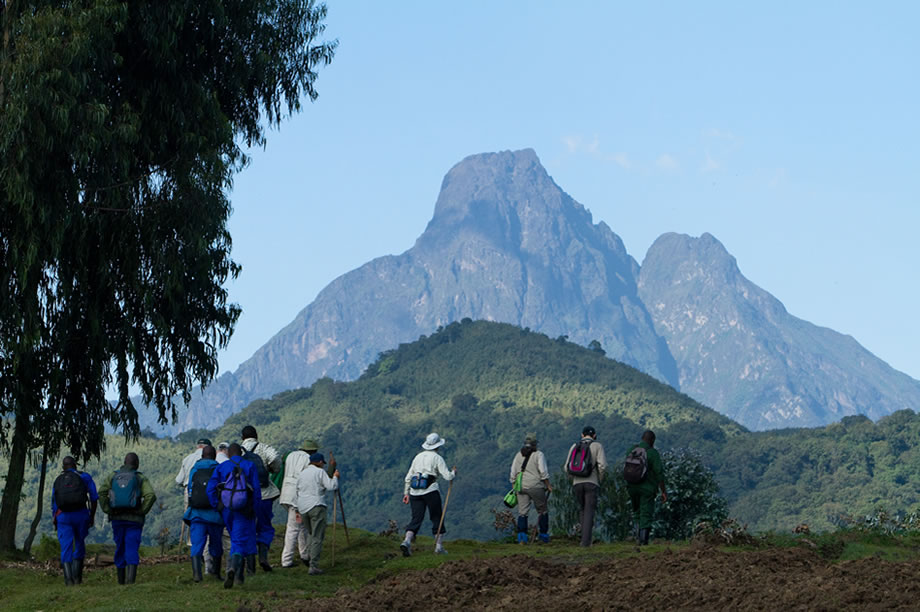It’s 10:30am on April 2 in Rwanda’s Volcanoes National Park. Bamboo trees rise about 40 metres into the sky and create canopies. The air, which is quite thick, is perfumed with fresh smells of foliage.
We are in the section of the park that is home to the critically endangered mountain gorillas, whose numbers declined dramatically in the 1970s due to habitat loss, war, disease and illegal wildlife activities.
We’ve been hiking through the forest for close to an hour now and one of my colleagues, a female Ugandan journalist, is looking increasingly exhausted.
Our group comprises seven journalists and about 36 field assessors who are involved in the latest wild mountain gorilla census that is being conducted in the Virunga massif, a chain of eight volcanic mountains that straddle Rwanda, the Democratic Republic of Congo (DRC) and Uganda.
Unlike other wildlife censuses where small areas are surveyed and just a small number of animals is counted and multiplied proportionally according to the actual size of the area where the animals reside, the mountain gorilla census here is a more intricate and time-consuming exercise.
How the census is conducted
This expedition does not involve the physical finding and counting of individual gorillas but rather, scouring the forest in search of gorilla trails and nest sites.
To get accurate — or, at least, close to accurate — census results, the entire Virunga massif is divided and mapped into sectors that are thoroughly covered by field assessors who are spaced no further than 500 metres apart.
For this round’s census, six teams of assessors from 10 conservation concerns from Rwanda, DRC and Uganda have been put together to collect data in an exhausting exercise that is running for eight months — from October 2015 until the end of May this year.
These assessors are trained and equipped with the necessary skills required to understand the structures and movements of gorillas so that they can avoid doubling the animals as they move around the forest.
We came across our first trail after about an hour of hiking this tri-national forested area and followed it for a couple of metres in search of gorilla nest sites.
“We follow a trail that is less than five days old and look out for gorilla nest sites (gorillas don’t sleep in the same place for more than a day so they make different nests every day) and get their dung from which we take faecal samples,” says Christopher Byaruhanga, a research assistant at the Institute of Tropical Forest Conservation in Uganda who is part of one of the field teams in this round’s mountain gorilla census.
When we encounter the first gorilla dung, the field team starts off by measuring its size which, we are told, partly helps scientists to establish age classes of the gorillas (infant, juvenile or silverback). The larger the size of the dung, the older the gorilla. And if the dung contains some silver hair, that’s an indicator that it came from a silverback.
But that is not enough.
Next, the field teams use wooden sticks to carry samples of gorilla dung, which is then carefully stored in a test tube for DNA tests afterwards.
“During this process we wear gloves in order to avoid contaminating the dung with human DNA,” says Byaruhanga, who on that day was leading a team of six assessors.
DNA tests
These samples are then sent to a laboratory for wildlife scientists to analyse each one of them for individual DNA identifiers, a process that ensures that each mountain gorilla is counted only once.
This is another long process that lasts a couple of months. While the field assessors will be through with collecting these samples by the end of May this year, census results are expected to be ready in 2017, according to Anna Behm Masozera, the director at International Gorilla Conservation Programme, one of the organizations at the forefront of this census.
However, apart from determining the number of gorillas in the Virunga massif, the on-going census also aims to reveal the demographics, number and size of family groups.
In addition, scientists will also use the data collected to determine where gorilla groups are located in relation to vegetation types, other groups, and human activities, among other elements.
Away from gorillas, this census will also provide useful information for the successful running of the three national parks (Volcanoes in Rwanda, Mgahinga in Uganda and Virunga in DRC) where these mountain gorillas reside. In the process of searching for gorilla trails, field assessors also record signs of illegal activities that they may encounter, along with signs or sightings of other animals in the parks.
Frequency
The mountain gorilla census is conducted after every five years in order to keep track of mountain gorilla populations, their mortality rates, etc. This helps scientists to establish causes of premature deaths, growth spurts or slumps in breeding, which in turn helps stakeholders to make the right decisions regarding the care of these critically endangered species.
The 2010 census results concluded that there were 480 mountain gorillas in the Virunga massif, but their numbers have since been increasing. The census also found out that about 400 of them resided in Uganda’s Bwindi Impenetrable National Park, bringing the total number of the world’s remaining mountain gorillas to 880.
This year’s census, which is being carried out collaboratively by scientists and park authorities from all the three countries under the umbrella of Greater Virunga Transboundary Collaboration, is expected to indicate an upward trajectory.
The census is supported by the International Gorilla Conservation Programme (a coalition of Fauna & Flora International and WWF), Max Planck Institute for Evolutionary Anthropology, Dian Fossey Gorilla Fund International, Institute of Tropical Forest Conservation, Gorilla Doctors, and North Carolina Zoo.
It is funded through contributions from Fauna & Flora International, WWF and Partners in Conservation at the Columbus Zoo & Aquarium.
